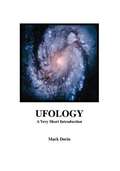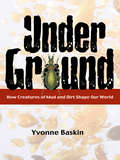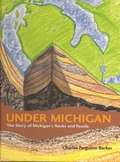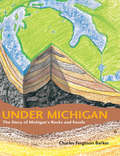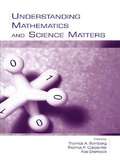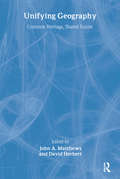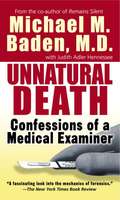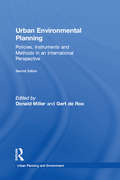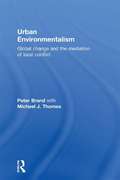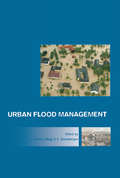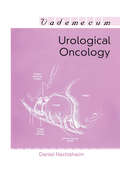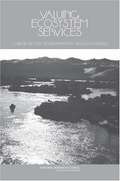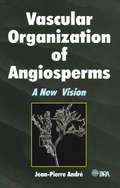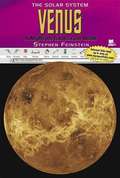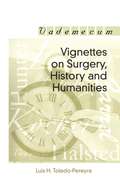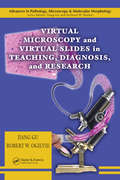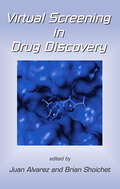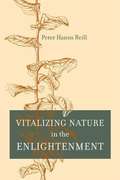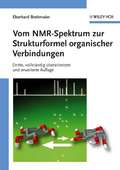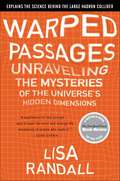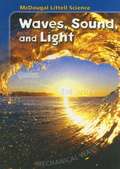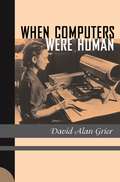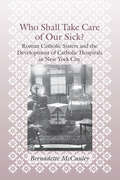- Table View
- List View
Ubiquitin-Proteasome Protocols
by Cam Patterson Douglas M. CyrA collection of cutting-edge techniques for studying ubiquitin-dependent protein degradation via the proteasome. The topics covered range broadly from basic biochemistry to cellular assays to discovery techniques using mass spectrometric analysis. These biochemical and cellular methods are necessary to explore the ubiquitin-proteasome system and ubiquitin-proteasome-dependent functions. State-of-the-art and user-friendly, Ubiquitin-Proteasome Protocols offers novice and experienced bench scientists alike a thorough compendium of readily reproducible techniques that will accelerate discovery, enhance productivity, and permit manipulation of the system for varied research purposes.
Ufology: A Very Short Introduction
by Mark DorioUfology: Presents a serious survey of the study of UFOs and related phenomena, providing a good first step toward understanding this topic.
Under Ground: How Creatures of Mud and Dirt Shape Our World
by Yvonne BaskinIn childhood, the backyard, the flowerbed, the beach, puddles, lakes, and streams are infinitely fascinating. It is a mistake to leave that "childish" fascination with mud behind. The soils of the Earth, whether underneath our feet or pressurized beneath tons of ocean water, hold life in abundance. A handful of garden dirt may harbor more species than the entire aboveground Amazon.The robotic rovers Spirit and Opportunity made headlines as they searched the Martian landscape for signs of life. But while our eyes have been turned toward the skies, teeming beneath us and largely unexplored lies what Science magazine recently called the true "final frontier." A growing array of scientists is exploring life in soils and sediments, uncovering a living world alien to our own senses--and yet one whose integrity turns out to be crucial to life above ground. Yvonne Baskin takes the reader from the polar desert of Antarctica to the coastal rain forests of Canada, from the rangelands of Yellowstone National Park to the vanishing wetlands of the Mississippi River basin, from Dutch pastures to English sounds, and beyond. She introduces exotic underground creatures and shows us what scientists are learning about their contribution to sustaining a healthy world above ground. She also explores the alarming ways in which air pollution, trawl fishing, timber cutting, introductions of invasive species, wetland destruction, and the like threaten this underground diversity and how their loss, in turn, affects our own well being.Two-thirds of the world's biological diversity exists in soils and underwater sediments, and yet most of us remain unaware of these tiny multitudes that run the planet beneath the scenes. In Under Ground, Baskin reveals the startling ways in which that life, whether in our own back yards, in fields and forests, or in the furthest reaches of the Earth, is more significant and fascinating than we once imagined.
Under Michigan: The Story of Michigan's Rocks and Fossils
by Charles Ferguson BarkerMost people recognize Michigan by its mitten-shaped Lower Peninsula and the Great Lakes embracing the state. Underneath the earth's surface, however, is equally distinctive evidence of an exciting history. Michigan rests on sedimentary rocks that reach down into the earth's crust more than fourteen thousand feet-a depth three-and-a-half times deeper than the Grand Canyon. Within these layers of rock rest all sorts of ancient fossils and minerals that date back to the eras when tropical seas spread across Michigan and hot volcanoes flung molten rock into its skies-long before mile-thick glaciers bulldozed over Michigan and plowed through ancient river valleys to form the Great Lakes. Under Michigan is the first book for young readers about the geologic history of the state and the structure scientists call the Michigan Basin. A fun and educational journey, Under Michigan explores Earth's geological past, taking readers far below the familiar sights of Michigan and nearby places to explain the creation of minerals and fossils and show where they can be found in the varying layers of rock. Readers will learn about the hard rock formations surrounding Michigan and also discover the tall mountain ridges hidden at the bottom of the Great Lakes. With beautiful illustrations by author Charles Ferguson Barker, a glossary of scientific terms, and charming page to keep field notes, Under Michigan is a wonderful resource for young explorers to use at home, in school, or on a trip across Michigan.
Under Michigan: The Story of Michigan's Rocks and Fossils (Great Lakes Books Series)
by Charles Ferguson BarkerMost people recognize Michigan by its mitten-shaped Lower Peninsula and the Great Lakes embracing the state. Underneath the earth's surface, however, is equally distinctive evidence of an exciting history. Michigan rests on sedimentary rocks that reach down into the earth's crust more than fourteen thousand feet--a depth three-and-a-half times deeper than the Grand Canyon. Within these layers of rock rest all sorts of ancient fossils and minerals that date back to the eras when tropical seas spread across Michigan and hot volcanoes flung molten rock into its skies--long before mile-thick glaciers bulldozed over Michigan and plowed through ancient river valleys to form the Great Lakes.Under Michigan is the first book for young readers about the geologic history of the state and the structure scientists call the Michigan Basin. A fun and educational journey, Under Michigan explores Earth's geological past, taking readers far below the familiar sights of Michigan and nearby places to explain the creation of minerals and fossils and show where they can be found in the varying layers of rock. Readers will learn about the hard rock formations surrounding Michigan and also discover the tall mountain ridges hidden at the bottom of the Great Lakes. With beautiful illustrations by author Charles Ferguson Barker, a glossary of scientific terms, and charming page to keep field notes, Under Michigan is a wonderful resource for young explorers to use at home, in school, or on a trip across Michigan.
Understanding Human Anatomy & Physiology (5th edition)
by Sylvia S. MaderThis book will help entry-level students understand and enjoy the principles of human anatomy and physiology providing them up-to-date informative content with effective learning systems, piecing together the facts and fascination of human anatomy and physiology.
Understanding Mathematics and Science Matters (Studies in Mathematical Thinking and Learning Series)
by Thomas A. Romberg, Thomas P. Carpenter and Fae DremockThe research reported in this book provides reliable evidence on and knowledge about mathematics and science instruction that emphasizes student understanding--instruction consistent with the needs of students who will be citizens in an increasingly demanding technological world.The National Center for Improving Student Learning in Mathematics and Science--established in 1996 as a research center and funded by the U.S. Department of Education--was instrumental in developing instructional practices supportive of high student achievement in and understanding of mathematics and science concepts. NCISLA researchers worked with teachers, students, and administrators to construct learning environments that exemplify current research and theory about effective learning of mathematics and science. The careful programs of research conducted examined how instructional content and design, assessment, professional development, and organizational support can be designed, implemented, and orchestrated to support the learning of all students. This book presents a summary of the concepts, findings, and conclusions of the Center's research from 1996-2001.In the Introduction, the chapters in Understanding Mathematics and Science Matters are situated in terms of the reform movement in school mathematics and school science. Three thematically structured sections focus on, respectively, research directed toward what is involved when students learn mathematics and science with understanding; research on the role of teachers and the problems they face when attempting to teach their students mathematics and science with understanding; and a collaboration among some of the contributors to this volume to gather information about classroom assessment practices and organizational support for reform.The goal of this book is to help educational practitioners, policymakers, and the general public to see the validity of the reform recommendations, understand the recommended guidelines, and to use these to transform teaching and learning of mathematics and science in U.S. classrooms.
Unifying Geography: Common Heritage, Shared Future
by John A. Matthews David T. HerbertIt can be argued that the differences in content and approach between physical and human geography, and also within its sub-disciplines, are often overemphasised. The result is that geography is often seen as a diverse and dynamic subject, but also as a disorganised and fragmenting one, without a focus.Unifying Geography focuses on the plural and competing versions of unity that characterise the discipline, which give it cohesion and differentiate it from related fields of knowledge. Each of the chapters is co-authored by both a leading physical and a human geographer. Themes identified include those of the traditional core as well as new and developing topics that are based on subject matter, concepts, methodology, theory, techniques and applications.Through its identification of unifying themes, the book will provide students with a meaningful framework through which to understand the nature of the geographical discipline. Unifying Geography will give the discipline renewed strength and direction, thus improving its status both within and outside geography.
Unnatural Death: Confessions Of A Medical Examiner
by Michael Baden Judith A. Hennesee* JFK's autopsy failed to disclose crucial evidence. * The deaths of John Belushi and Elvis Presley were far more complex than anyone has let on. * Decisive medical findings in the von Bulow affair were consistently overlooked. These are but three of the shocking revelations in Dr. Michael Baden's first-person, no-holds-barred account of his distinguished career in forensic pathology. In determining the causes of tens of thousands of deaths, from those of presidents and rock stars to victims of serial killings, exotic sex rituals, mass disasters, child abuse and drug abuse, Baden has come to the unavoidable conclusion that the search for scientific truth is often sullied by the pressures of expediency. He produces dramatic evidence to demonstrate that political intrigue, influence peddling, and professional incompetence have created a national crisis in forensic medicine. "A fascinating look into the mechanics of forensics and a disconcerting lesson in the politics of death.
Urban Environmental Planning: Policies, Instruments and Methods in an International Perspective (Urban Planning and Environment)
by Donald Miller Gert De RooOriginally published in 1997, Urban Environmental Planning provides a groundbreaking overview of innovative methods and techniques for measuring and managing the environmental effects of urban land uses on other urban activities. Fully revised and updated, this second edition brings together a team of leading environmental planners and policy makers from the US, UK, Europe and SE Asia to address the central questions confronting sustainable urban development. Typical questions include: How can you measure and manage the negative environmental effects of intrusive urban activities such as manufacturing and transport on sensitive land uses including residential and recreational areas? Can a balance be found between reducing these effects through means such as separating conflicting land uses? While other sources identify the need for effective programmes to improve urban environmental quality, this volume describes and assesses analytical methods and implementing programmes practised by leading communities around the world.
Urban Environmentalism: Global Change and the Mediation of Local Conflict
by Michael Thomas Peter BrandA critical examination of urban policies and management practices used to make cities sustainable. With an international perspective, the book describes urban environmental agendas and how they arose in the context of globalization, urban economic restructuring, and the need to make cities competitive. It argues that the environment became an integral part of city development policy, turning attention not only to physical and ecological issues but also to improving the economic performance of cities and the lives of citizens. The authors also go beyond the technical issues to explore the political importance of urban environmentalism, using case studies to illustrate both its international scope and place-specific characteristics which are inexorably influencing city development throughout the world. In connecting the concept to its political effects, the book raises issues such as local democracy, equality and social regulation, all of which are increasingly concerning academics, professionals, environmentalists and city authorities alike.
Urban Flood Management: Introduction - 1st International Expert Meeting on Urban Flood Management
by Chris Zevenbergen Andras Szollosi-NagyOver the last decades the world has witnessed a growing number of floods in urban areas. Climate change and rapid urbanization will exacerbate this trend. Flooding incidents in urbanized catchments and low-lying areas, such as polders, can lead to great public concern and anxiety, and their economical impact is severe. Apart from well-known flood prevention strategies, new approaches to the accommodation of floods are needed to create robust and sustainable solutions that enable us to cope with the ever-increasing urban pressure on flood-prone areas and the uncertainties created by climate change. Urban Flood Management comprises a multidisciplinary survey of recent developments in this field. Subjects like spatial and urban planning, flood insurance, flood resilience, flood proofing techniques, risk perception and preparedness and flood forecasting are treated by authorities from Brazil, India, the USA and Europe. Urban Flood Management will provide anyone active in the fields of water, risk and urban management with the latest information and insights that were obtained with a global and multidisciplinary approach.
Urological Oncology
by Daniel A. NachtsheimThis book reviews the major urological tumors and supports the idea that early detection and surgical removal of the tumor results in long-term survival. It describes the treatment of prostatic cancer, and presents the three points of view for treatment of this complex issue.
Valuing Ecosystem Services: Toward Better Environmental Decision-making
by National Research Council of the National AcademiesNutrient recycling, habitat for plants and animals, flood control, and water supply are among the many beneficial services provided by aquatic ecosystems. In making decisions about human activities, such as draining a wetland for a housing development, it is essential to consider both the value of the development and the value of the ecosystem services that could be lost. Despite a growing recognition of the importance of ecosystem services, their value is often overlooked in environmental decision-making. This report identifies methods for assigning economic value to ecosystem services—even intangible ones—and calls for greater collaboration between ecologists and economists in such efforts.
Vascular Organization of Angiosperms: A New Vision
by Jean-Pierre AndreThis study of plant anatomy is based on newly available data on the structure and spatial organization of the vascular system of plants. For the first time, by means of a new technique of intracellular moulding, the vascular system can be observed in its length. Many examples are chosen from among the major groups of the plant kingdom to illustrate
Venus: A MyReportLinks.com Book
by Stephen Feinstein.This is a nice summary of the properties and features of Venus, the second planet out from the sun.
Vignettes on Surgery, History and Humanities
by Luis Horacio Toledo-PereyraThis book introduces writings on the history and philosophy of surgery that previously appeared in the Journal of Investigative Surgery. It attempts to reach students of history in general and those interested in the history and philosophy of surgery in particular.
Virtual Microscopy and Virtual Slides in Teaching, Diagnosis, and Research (Advances in Pathology, Microscopy, & Molecular Morphology)
by Jiang Gu Robert W. OgilvieDespite a brief history, the technologies of virtual microscopy and virtual slides have captured the imagination of many, especially this current crop of students. Having come of age in the computer and Internet age, this emerging group of technicians and researchers tends to display a distinct preference for virtual slides and virtual microscopes.
Virtual Screening in Drug Discovery
by Juan Alvarez Brian ShoichetVirtual screening can reduce costs and increase hit rates for lead discovery by eliminating the need for robotics, reagent acquisition or production, and compound storage facilities. The increased robustness of computational algorithms and scoring functions, the availability of affordable computational power, and the potential for timely structural
Vitalizing Nature in the Enlightenment
by Peter Hanns ReillThis study redraws the intellectual map of the Enlightenment and reassesses the legacy of that highly influential period for us today. Peter Hanns Reill argues that in the middle of the eighteenth century, a major shift occurred in the way Enlightenment thinkers conceived of nature that caused many of them to reject the prevailing doctrine of mechanism and turn to a vitalistic model to account for phenomena in natural history, the life sciences, and chemistry.
Vom NMR-Spektrum zur Strukturformel organischer Verbindungen: Ein Kurzes Praktikum Der Nmr-spektroskopie (Teubner Studienbücher Chemie Ser.)
by Eberhard BreitmaierJetzt in der dritten, uberarbeiteten, erweiterten, deutschsprachigen Auflage! Dieses NMR-Lehrbuch bietet dem Leser eine praxisnahe Hilfe bei der Ubersetzung von NMR-Spektren in die Struktur organischer Verbindungen. Nach einer sehr kurzen theoretischen Einleitung, in der die wichtigsten Begriffe erklart werden, folgt eine Einfuhrung in die Strategie und Taktik der Strukturaufklarung mit NMR-Methoden. Ein Schwerpunkt sind 55 Fallstudien mit Spektren bzw. Spektrenserien abgestuften Schwierigkeitsgrades zum Selbststudium sowie ausfuhrliche Losungsvorschlage zum Nachvollziehen. Neu hinzugekommen sind einige aktuelle zweidimensionale NMR-Experimente der heteronuklearen und homonuklearen Korrelation chemischer Verschiebungen sowie neue Aufgaben zu deren Anwendung. Dieser Klassiker unter den NMR-Lehrbuchern ist unentbehrlich fur jeden, der zur Aufklarung organischer Strukturen die NMR-Spektroskopie anwendet.
Warped Passages: Unraveling the Mysteries of the Universe's Hidden Dimensions
by Lisa RandallThe universe has many secrets. It may hide additional dimensions of space other than the familier three we recognize. There might even be another universe adjacent to ours, invisible and unattainable . . . for now.Warped Passages is a brilliantly readable and altogether exhilarating journey that tracks the arc of discovery from early twentieth-century physics to the razor's edge of modern scientific theory. One of the world's leading theoretical physicists, Lisa Randall provides astonishing scientific possibilities that, until recently, were restricted to the realm of science fiction. Unraveling the twisted threads of the most current debates on relativity, quantum mechanics, and gravity, she explores some of the most fundamental questions posed by Nature—taking us into the warped, hidden dimensions underpinning the universe we live in, demystifying the science of the myriad worlds that may exist just beyond our own.
Waves, Sound, and Light
by Mcdougal-Littell StaffEach chapter in Waves, Sound, and Light covers some of the learning goals that are described in the National Science Education Standards (NSES) and the Project 2061 Benchmarks for Science Literacy.
When Computers Were Human
by David Alan GrierBefore Palm Pilots and iPods, PCs and laptops, the term "computer" referred to the people who did scientific calculations by hand. These workers were neither calculating geniuses nor idiot savants but knowledgeable people who, in other circumstances, might have become scientists in their own right. When Computers Were Human represents the first in-depth account of this little-known, 200-year epoch in the history of science and technology. Beginning with the story of his own grandmother, who was trained as a human computer, David Alan Grier provides a poignant introduction to the wider world of women and men who did the hard computational labor of science. His grandmother's casual remark, "I wish I'd used my calculus," hinted at a career deferred and an education forgotten, a secret life unappreciated; like many highly educated women of her generation, she studied to become a human computer because nothing else would offer her a place in the scientific world. The book begins with the return of Halley's comet in 1758 and the effort of three French astronomers to compute its orbit. It ends four cycles later, with a UNIVAC electronic computer projecting the 1986 orbit. In between, Grier tells us about the surveyors of the French Revolution, describes the calculating machines of Charles Babbage, and guides the reader through the Great Depression to marvel at the giant computing room of the Works Progress Administration. When Computers Were Human is the sad but lyrical story of workers who gladly did the hard labor of research calculation in the hope that they might be part of the scientific community. In the end, they were rewarded by a new electronic machine that took the place and the name of those who were, once, the computers.
Who Shall Take Care of Our Sick?: Roman Catholic Sisters and the Development of Catholic Hospitals in New York City (Medicine, Science, and Religion in Historical Context)
by Bernadette McCauleyThis rich history chronicles the prominent role of Catholic women religious in establishing the hospitals at the core of New York City's extensive Catholic medical network. Beginning with the opening of St. Vincent's Hospital in 1849, Bernadette McCauley relates how determined and pragmatic women of faith worked over the next eighty years to place the Catholic Church in the mainstream of American medicine.Exploring the differences and similarities between Catholic hospitals and other hospitals, McCauley describes the particular cultural sensibility and management style that informed Catholic health care and gauges the ultimate success of Catholic efforts. Visionary sisters established, managed, and staffed the hospitals, and they sat on hospital boards and served as administrators at a time when women rarely occupied positions of leadership in business. McCauley illustrates how they at once embraced the world of God and the world of man, playing an unheralded role in the development of the modern hospital while serving the daily needs of New York's immigrant poor.Encompassing such issues as immigration, the education of nurses and doctors, hospital care and organization, and the role of women in the Catholic church, this extensive study is a valuable resource for scholars and students in the history of medicine, history of nursing, American religion, and women's history.

